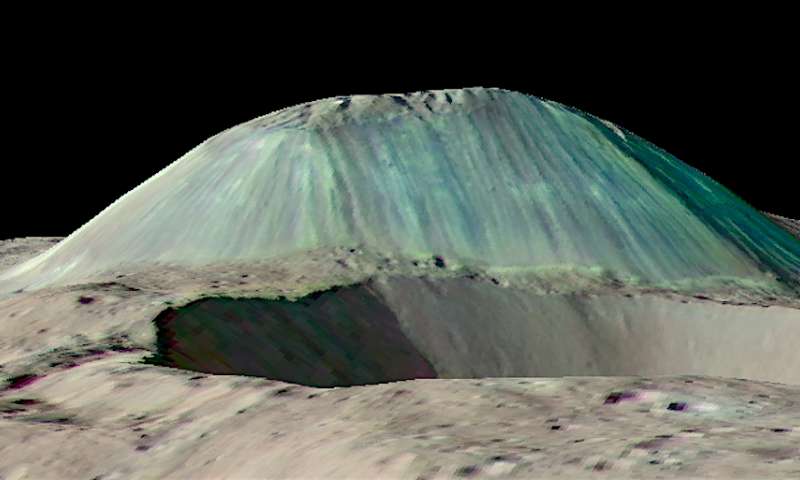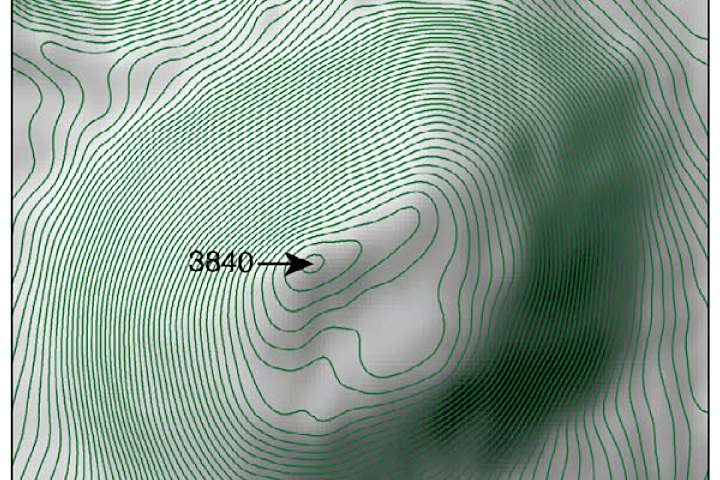This one is fascinating. Ceres, the dwarf planet currently being visited by the Dawn Mission spacecraft has a volcanic dome rising near what is thought to be an impact crater. Not much is said about the latter but the dome rises 13,000 feet and spreads 11 miles across at the base …. (see http://phys.org/print391960502.html) …
 … Ceres itself is just 600 miles wide – somewhat small for such a large dome feature. Even more peculiar the volcanic bulge is not made from lava as one would expect on earth but from ice (or material that has frozen). A paper has been published in the journal Science that claims that although the surface of Ceres is something like minus 40 degrees Celsius (or less) the interior of Ceres must be considerably warmer otherwise liquid water or brines could not exist – which then freeze when reaching the surface.
… Ceres itself is just 600 miles wide – somewhat small for such a large dome feature. Even more peculiar the volcanic bulge is not made from lava as one would expect on earth but from ice (or material that has frozen). A paper has been published in the journal Science that claims that although the surface of Ceres is something like minus 40 degrees Celsius (or less) the interior of Ceres must be considerably warmer otherwise liquid water or brines could not exist – which then freeze when reaching the surface.
We appear to have a lot of guesswork here but such theories will eventually coalesce into an explanation acceptable to most scientists. For instance, elsewhere on Ceres there are features formed by cryovolcanism activity and there are some impressive craters with floors that are flat and wide, quite unlike anything that can be attributed to impact events. It is possible, the author speculates, that the bottoms of such craters have been partially filled in to present a flat like feature to the camera eye. As the flat bottoms are common to a lot of cratering this explanation is unlikely and one will have to abide by observation – and flat bottoms are what can be seen. Some of these craters have bright spots on the floor – and cryovolcanic domes (possibly rich in sodium carbonates). Other white spots occur over fractures – where vented material (such as water mixed with salts to form a brine) may have oozed out and then dried out to leave behind a salty crust.
Geologists think the surface of Ceres might not be wholly rocky but is partly made up of ices. The interior is being modelled – and here is a contour model of the volcanic dome …
 … NASA plan to continue to orbit Ceres with the Dawn spacecraft and will beam back down data far another 2 years. The dwarf planet, as it is described, is slowing moving towards perihelion (the closest point at which it reaches the sun) and this may spark some activity. It seems that scientists might be thinking Ceres in some ways resembles a dead comet rather than just a space rock orbiting between Mars and Jupiter.
… NASA plan to continue to orbit Ceres with the Dawn spacecraft and will beam back down data far another 2 years. The dwarf planet, as it is described, is slowing moving towards perihelion (the closest point at which it reaches the sun) and this may spark some activity. It seems that scientists might be thinking Ceres in some ways resembles a dead comet rather than just a space rock orbiting between Mars and Jupiter.
At http://phys.org/print391960095.html .. we learn there are six papers on Ceres in the recently published issue of Science (the week of Sept !st 2016). One of these discusses the composition of Ceres as it contains phyllosilicate minerals which include magnesium and ammonia. Such minerals require the presence of water to form.
